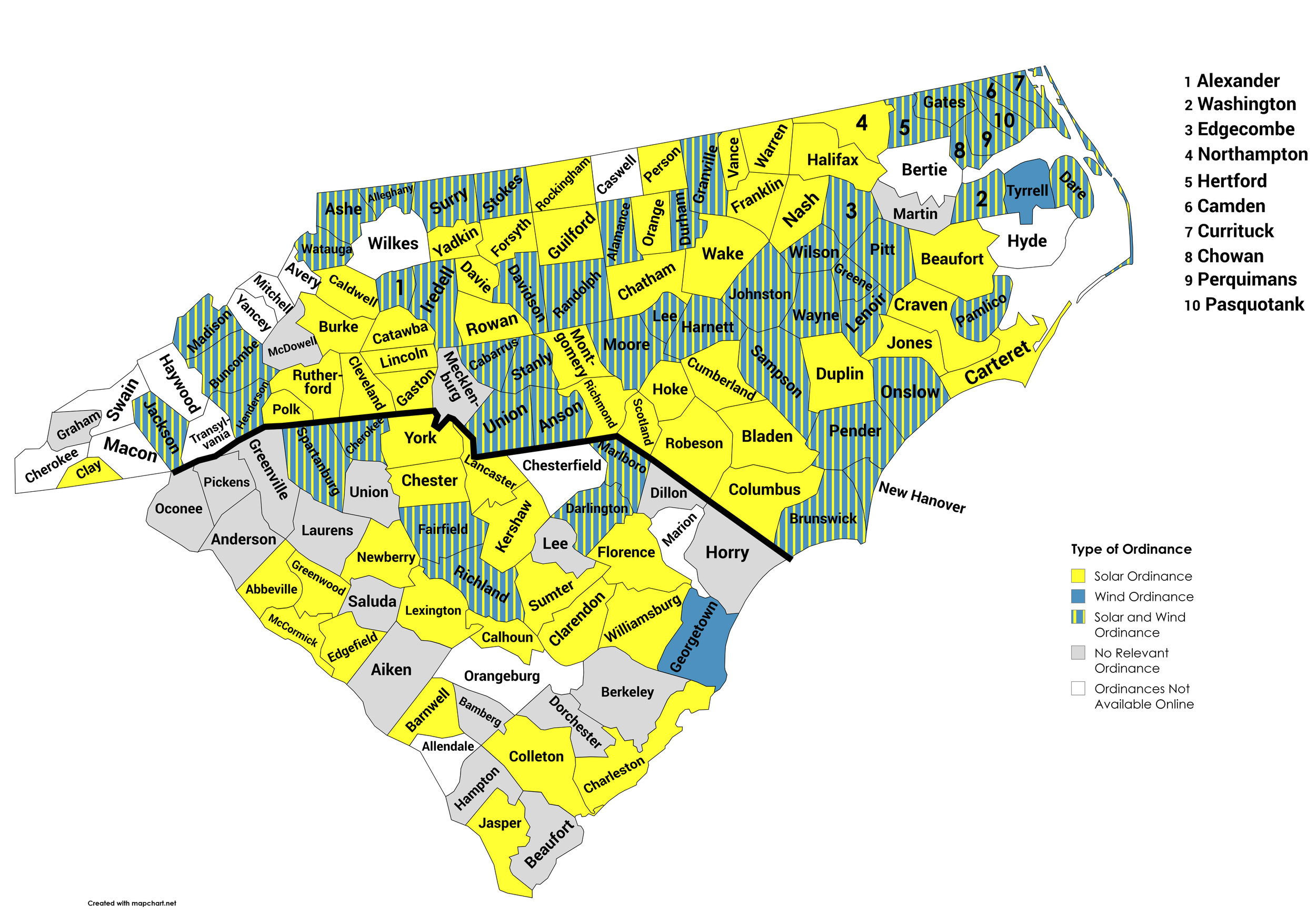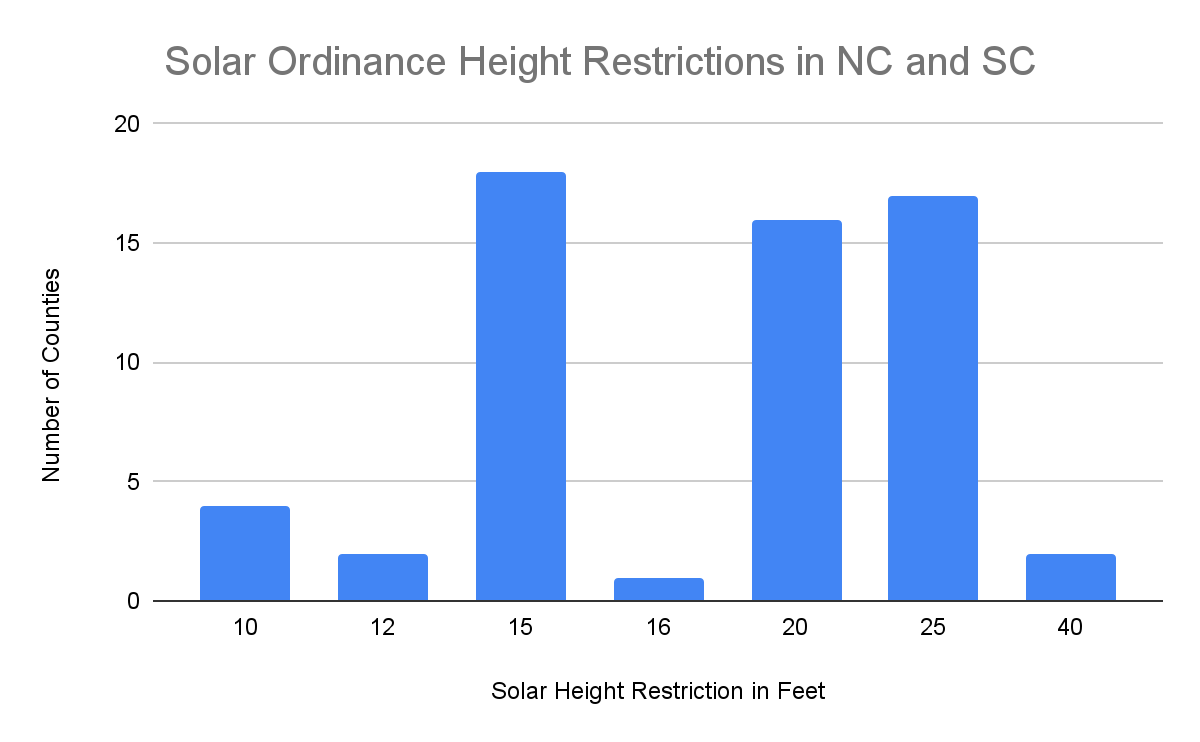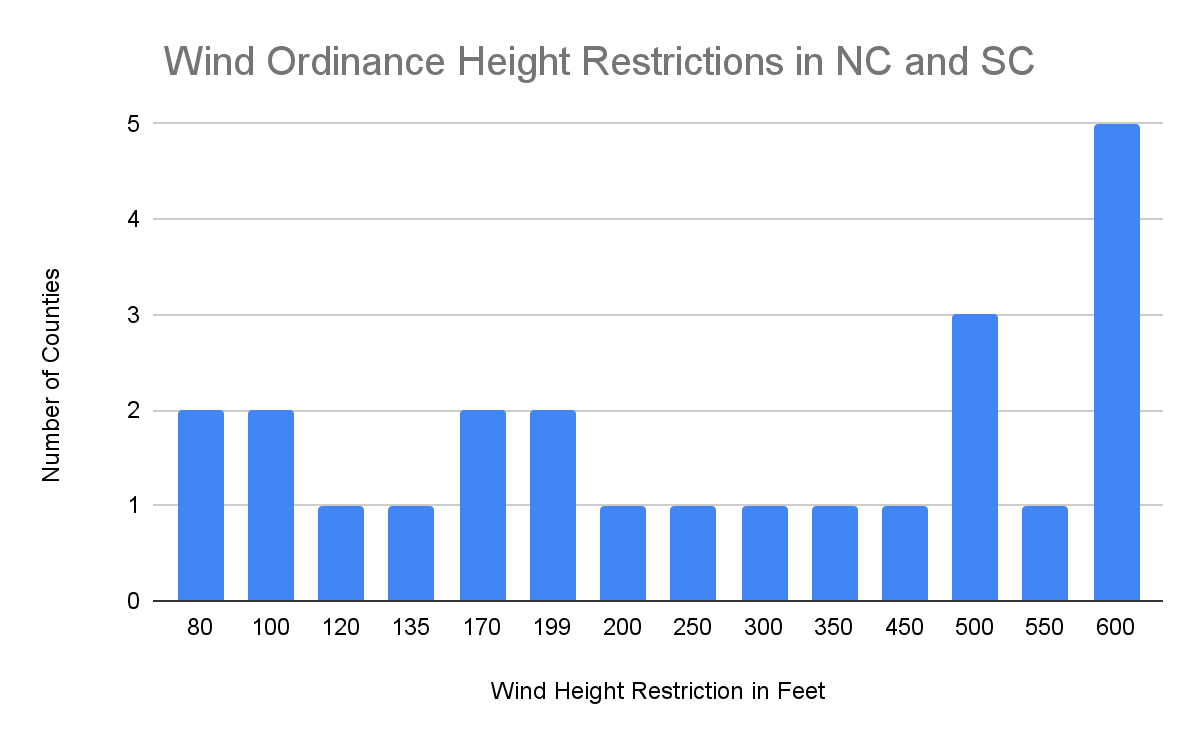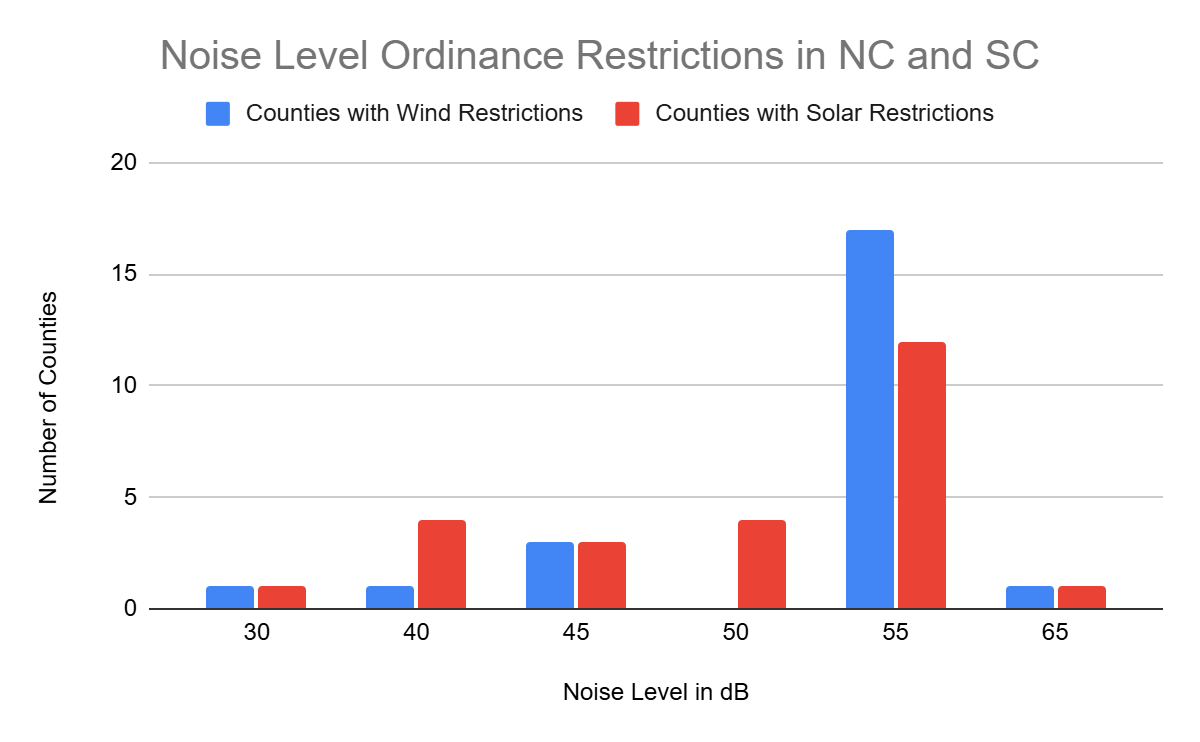By: Emily Apadula, Policy Analyst, Cleo Carter, Policy Analyst, and David Sarkisian, Principal Policy Analyst
As most states continue to advance their renewable energy goals, the need for more renewable energy facilities also continues to grow. This increased demand has led to a focus on local siting and permitting rules. While state rules and regulations may encourage the development of renewable energy facilities, the final decision of where and how these facilities can be located often lies at the local level.
While compiling a database of local utility-scale renewable energy ordinances in the Carolinas, the North Carolina Clean Energy Technology Center team observed several trends across ordinances. In most cases, the states’ ordinances were more similar than different, for example, in the types of provisions included. Across the two states, most ordinances included technology definitions (88 counties) and setbacks (87 counties). While only eight out of the total 146 counties included provisions for community engagement. In contrast, one of the major differences between the two states was the inclusion of battery storage. While no counties in either state had provisions for standalone battery storage systems, eleven counties in North Carolina included solar plus storage ordinances, while no county in South Carolina had such language.
Lack of Ordinance Accessibility
Some counties do not have their zoning ordinances available online. The lack of readily available documentation was similar in both states with about 12% of counties in North Carolina not publishing their ordinances online and about 15% in South Carolina.
Percentage of Ordinances Mentioning Applicable Technologies
A key difference between ordinances in South Carolina and North Carolina is South Carolina’s lack of mentioning applicable renewable energy technologies. There are stark contrasts in the applicable technologies tracked including utility-scale solar, wind, and battery storage technologies and their inclusion in county ordinances. The most notable differences are that South Carolina county ordinances contain no battery storage provisions and almost 35% of their counties have no mention of renewable energy technologies at all.
More Provisions for Solar than Wind
Many more counties had provisions for solar development (83% in North Carolina and 54.25% in South Carolina) than for wind development (46% in North Carolina and 15.22% in South Carolina). More counties in North Carolina (91%) than South Carolina (65.22%) had provisions overall.
Lack of Standalone Storage Requirements
No counties have provisions for standalone energy storage in their zoning ordinances. When storage is discussed, it is always part of the solar ordinance, and is given cursory consideration at most.
Frequency of Requirements Referenced in Carolina County Ordinances
The requirements found most commonly in renewable energy ordinances are technology definitions, setbacks, fencing, buffers, height restrictions, and decommissioning plans. It is important to note that screening and buffers were often used interchangeably and predominantly categorized under buffers.
Variation in Technology Definitions
There are no uniform definitions for terms like solar farm or solar facility. Many of the definitions encompass facilities that are relatively small compared to the size of facilities usually being contemplated.
Varied Setback Distances
Setback distances for solar varied widely across counties. Some of the largest required setbacks were from scenic roadways (e.g. Brunswick County, NC - 500 feet from scenic byways; Chowan County, NC - 1,000 feet from scenic byways or historic sites) or historic sites, although the largest setback was for Alleghany County, NC, which had a setback distance of 2,000 feet from dwelling units and other protected uses. For wind, setbacks were usually calculated as some multiple of the height of the turbine(s).
Distance from Waterways
Five ordinances across the Carolinas specified a minimum distance from bodies of water and wetlands for solar facilities. This may reflect concerns about water contamination (or runoff from pesticides).
Standard Fencing Requirements
Fencing requirements predominantly specified a six foot fence (48 counties) for solar facilities sometimes requiring eight feet (eight counties). They varied on whether the fence material needed to be chain link or some opaque material, and whether it should be topped with barbed wire. There was one instance where an eight foot security fencing was required for wind facilities in Richland County, SC.
Vegetative Buffer Requirements
In North Carolina, many (51) ordinances specified the height at planting, height at maturity, width, spacing between plants, and/or species requirements (i.e. evergreen vs. deciduous, native species) of vegetative buffers. The actual values for these requirements varied.
Height Restrictions
Solar Visual Restrictions
A notable number of Carolina counties included glare prevention (31 counties) and anti-reflective coating (eight counties) in their visual restrictions. North Carolina included 20 of these glare prevention measures and South Carolina counties made up seven out of eight of anti-reflective coating measures.
Wind Visual Restrictions
Most counties with wind ordinance provisions required turbines to be a non-obtrusive color like white, off-white, or gray, and specified that lighting was limited to what was required by the FAA or other aviation regulations. Many ordinances also specified that no signage or advertisement was allowed
Shadow Flicker Limits
The restriction on shadow flicker for wind facilities (if present) was almost always no more than 30 hours per year at an occupied facility of a nonparticipating landowner (this was the case in all but two counties that had shadow flicker restrictions.
Noise Restrictions
The noise restriction for wind facilities (if present) was usually in the range of 40-55 decibels at an occupied facility of a nonparticipating landowner.
Similar Decommissioning Plan Requirements
When decommissioning plans are required, they usually have similar elements such as agreements with landowners, the party responsible for decommissioning, estimated cost of decommissioning, specification of manner of removal, method for ensuring funds will be available, and timeframe for decommissioning. The state decommissioning rules for North Carolina require identification of project owner and landowner, description of how decommissioning will be conducted, information on equipment to be salvaged, information on steps to restore property, estimated cost of decommissioning, and mechanism to satisfy financial assurance requirements.
Financial Surety
When ordinances have provisions about decommissioning, they often (36 counties) require a financial surety, frequently equaling 125% of the estimated cost of decommissioning. The ordinances vary on whether this cost is net of salvage value or if salvage value is excluded. Most required the cost of decommissioning to be estimated by a professional engineer licensed within the state. The North Carolina state decommissioning law does not require a specific financial surety amount.
Community Engagement
Very few ordinances (eight counties) had specific provisions for community engagement in the solar (or wind) zoning decision-making process. Community meetings may sometimes be part of the standard special use zoning permit process, which was out of the scope for this draft ordinance research.
Aviation Analyses
Many ordinances required aviation impact analyses to be completed.
Few Wildlife or Agrivoltaics Provisions
A couple of counties (e.g. Currituck County, NC and Edgefield County, SC) have provisions about pollinator habitat or require a percentage of land to be used for agriculture, and many have requirements about using native species in the vegetative buffer, while one county in South Carolina, Sumter, included a requirement for wildlife passageways. Other than these examples, there is a lack of provisions dealing with wildlife or agricultural impacts.
Minimum Lot Size
In North Carolina there were six instances of minimum lot sizes mentioned in their ordinances. These measurements varied in terms of technology type; for example Cleveland County specifies a minimum lot size of 10 acres for solar facilities compared to Chowan County minimum lot size of 500 acres. Chowan County has a larger requirement for wind facility lot sizes in relation to Dare County’s 25 acre requirement.
Maximum Percentage of County Land Area
Two county ordinances had a maximum percentage for the total amount of land in the county occupied by solar farms. Richmond County, NC specifies that at no time shall the amount of land permitted for all solar energy facilities be more than 5% of total land in Richmond County whereas Williamsburg County, SC sets the limit at 2%.
While this discussion focused on North and South Carolina, it represents a larger national trend of variance in the regulation of utility-scale solar and wind energy facilities regardless of states’ proximity to each other. This variance continues on a more granular level within each state. This can make it difficult for developers looking to invest in and build out new renewable energy facilities. If states, and the country as a whole, are to meet their clean energy goals, more clarity, transparency, and accessibility will be required when it comes to local ordinances.






